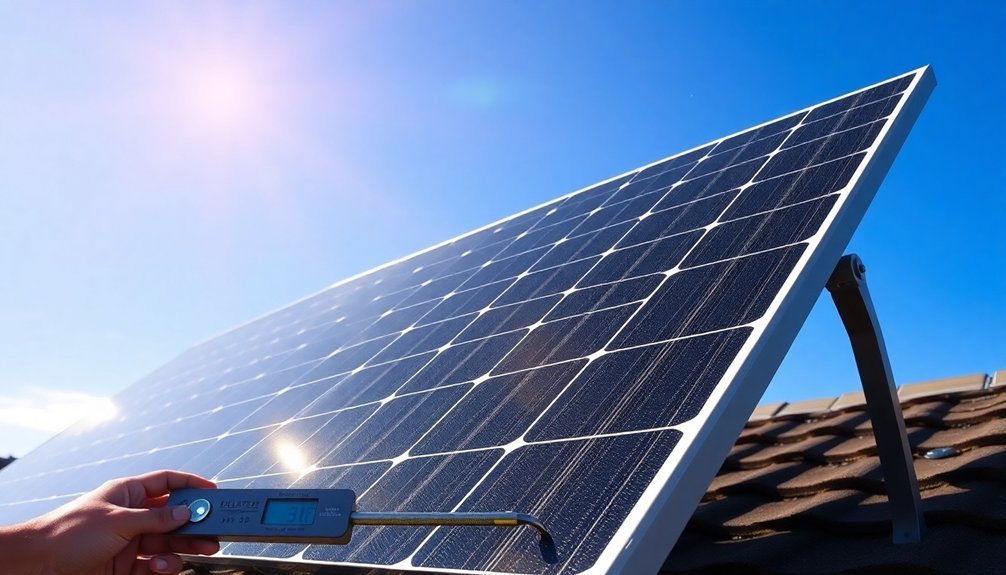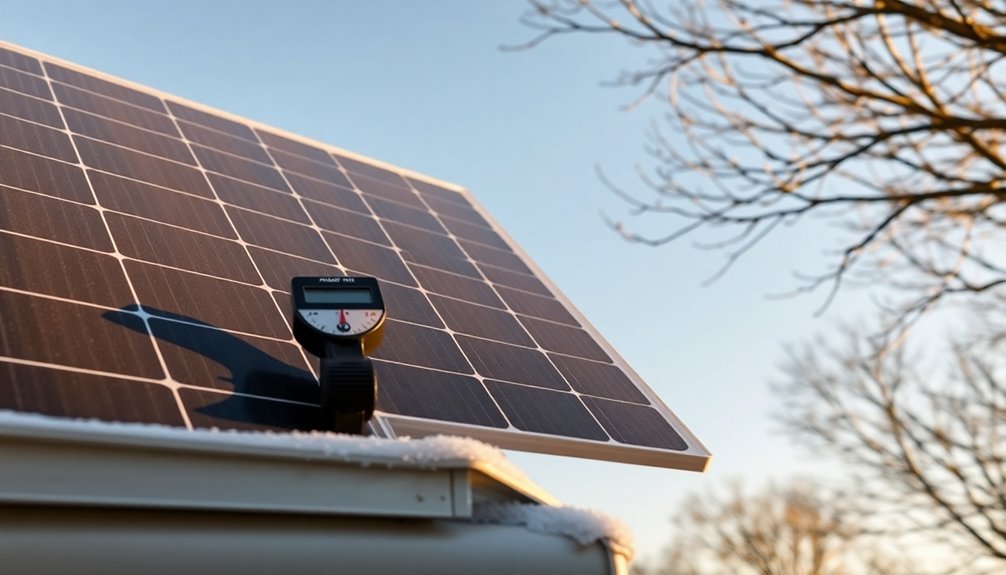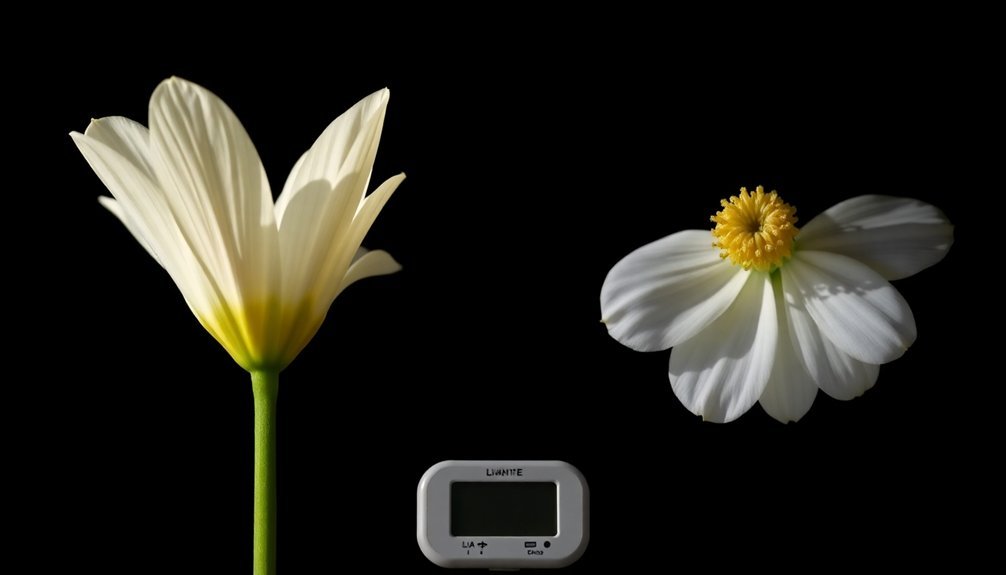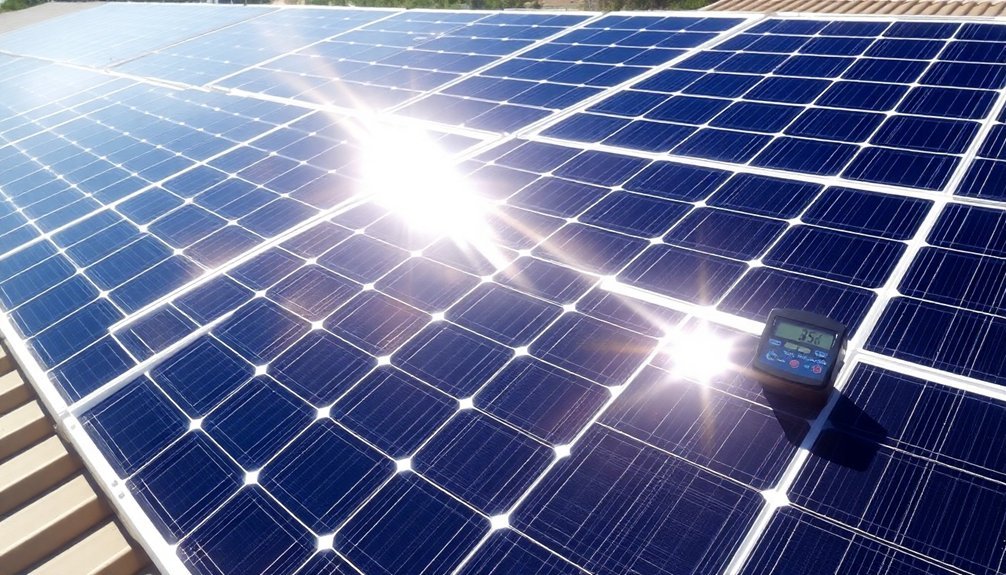For ideal solar exposure, you'll want to set your panels at an angle equal to your geographical latitude. If you're in the Northern Hemisphere, face panels south; if you're in the Southern Hemisphere, face north. You can boost efficiency by adjusting seasonally: add 15° to your latitude angle in winter and subtract 15° in summer. For example, at 34° latitude, you'd set panels at 49° in winter and 19° in summer. Proper alignment can increase your system's efficiency by up to 30%, and there's much more to take into account when maximizing your solar potential.
Finding Your Optimal Solar Angle

When determining the ideal angle for your solar panels, two key factors come into play: tilt and azimuth angles.
For tilt, you'll want to take into account your location's latitude. A simple rule of thumb is to set your panels at your latitude plus 15 degrees in winter and minus 15 degrees in summer. For example, if you're at 34° latitude, adjust between 49° in winter and 19° in summer. Regular adjustments to these angles can help achieve maximum solar output throughout the year.
For azimuth, point your panels toward true south if you're in the Northern Hemisphere, or true north if you're in the Southern Hemisphere.
Don't rely solely on a compass reading, as magnetic variations can lead to inaccuracies up to 25°. Getting the azimuth right is essential – proper alignment can boost your system's efficiency by up to 30%.
Understanding Solar Position Changes
The Sun's daily path across your sky creates an arc that peaks at solar noon, when it reaches its highest point and provides maximum intensity.
Throughout the year, you'll notice this arc shifts higher in summer and lower in winter due to Earth's 23.4-degree axial tilt, directly affecting the ideal angle for sun exposure. This variation is part of the obliquity cycle that repeats approximately every 41,000 years.
You can predict these solar position changes by understanding how your latitude influences both daily sun paths and seasonal variations, helping you maximize sun exposure for activities or solar installations.
Daily Sun Path Basics
Understanding daily sun paths begins with recognizing how Earth's tilted axis affects solar positioning throughout the year. You'll notice the sun's position changes daily, with sunrise and sunset points shifting along the horizon.
During equinoxes, you can observe the sun rising directly in the east and setting in the west. Post-equinox observations show the sun's position shifts from south to north each day.
To track the sun's movement, you'll need to take into account both its altitude and azimuth. The sun's altitude, or height above the horizon, peaks at midday and varies by season – higher in summer and lower in winter.
You can use sun path diagrams to determine ideal solar exposure times and identify potential shading obstacles. When observing the sun's movement, you'll find it's most noticeable around equinoxes, especially if you're at higher latitudes.
Seasonal Solar Variations
As Earth orbits the Sun throughout the year, its 23.45° axial tilt creates predictable seasonal variations in solar positioning and exposure.
You'll notice the most dramatic differences during the solstices, when the declination angle reaches its maximum (23.45°) on June 22 and minimum (-23.45°) on December 21-22.
The declination angle, which measures where sunlight hits Earth's equator, changes systematically through the seasons.
You can calculate this angle using a simple formula that factors in the day of the year.
During summer solstice in the Northern Hemisphere, you'll experience the most direct sunlight as your location tilts toward the Sun.
The difference in Earth's distance from the Sun during perihelion and aphelion has minimal impact on seasonal changes.
The opposite occurs during winter solstice.
At the equinoxes (March 22 and September 22), the declination angle becomes zero, creating equal day and night lengths.
Tracking Sun's Movement
Solar tracking systems offer several methods to maximize sun exposure throughout changing daily and seasonal patterns.
You'll find both active and passive systems that can help optimize your solar collection, with active systems using motors and sensors while passive ones rely on natural movement of fluids.
Key tracking approaches include:
- Uniform speed control moving at 15°/h
- Light intensity control using photosensitive cells
- Time-space control with precise algorithmic calculations
- Single or dual-axis tracking for different applications
Your tracking system's effectiveness depends on accurate altitude and azimuth measurements.
While dual-axis systems offer the most precise alignment by tracking both vertical and horizontal movement, single-axis options can still considerably improve energy collection.
Remember that environmental factors like cloud cover can affect tracking accuracy, especially with light-intensity methods.
Seasonal Angle Adjustments

To maximize the efficiency of your solar panels throughout the year, you'll need to adjust their tilt angle based on seasonal changes in the sun's position. The ideal tilt angle directly relates to your location's latitude.
In summer, set your panels at latitude minus 15 degrees, while in winter, adjust them to latitude plus 15 degrees.
You can boost your energy output by 10-25% through seasonal adjustments compared to fixed installations. While automated tracking systems offer precise control, manual adjustments work well for smaller setups.
You'll find various mounting options available to help you make these changes easily.
Remember to check for potential shade from trees or buildings when adjusting your panels. Regular maintenance and proper seasonal positioning will help shed snow and debris, ensuring your system maintains peak performance year-round.
Tracking The Sun's Path
Tracking the Sun's path means you'll need to account for both seasonal shifts and daily movement patterns to maximize your solar energy collection.
You'll notice the Sun's path varies throughout the year, rising higher in summer and staying lower in winter, which affects the best angle for your panels.
Your panels' direction and tilt can be optimized through either fixed seasonal adjustments or automated tracking systems that follow the Sun's daily east-to-west journey.
Seasonal Sun Path Changes
Understanding how the sun travels across the sky throughout the year is essential for maximizing solar exposure. The sun's path varies dramatically between seasons and hemispheres, directly impacting the ideal angle for solar collection.
Key seasonal patterns you'll need to take into account:
- During summer solstice, you'll see the sun reach its highest path, rising northeast and setting northwest in the Northern Hemisphere (opposite in Southern).
- Winter solstice brings the lowest sun path, with southeastern rises and southwestern sets in the Northern Hemisphere (opposite in Southern).
- At equinoxes, the sun rises due east and sets due west, regardless of your hemisphere.
- Your latitude affects sun angles considerably – the closer to the equator, the more consistent the sun's path.
These patterns will help you determine the best fixed or adjustable angles for your solar needs.
Daily Solar Movement Patterns
Since the sun travels predictably across the sky each day, you'll need to account for its east-to-west motion when positioning solar collectors.
Two key angles determine ideal positioning: solar altitude (the angle between the sun's rays and the horizon) and solar azimuth (the angle between the sun's position and true south).
You can track the sun's movement using either single-axis or dual-axis systems. Single-axis trackers rotate along a north-south axis to follow the sun's daily path, while dual-axis trackers adjust both horizontally and vertically for maximum exposure.
Even small tracking adjustments make a difference – a ±5° accuracy captures over 99.6% of available direct sunlight. You don't need ultra-precise tracking for most photovoltaic applications, as this level of accuracy already provides excellent energy collection.
Directional Light Optimization
When optimizing directional light for solar simulations, you'll need to account for both azimuth and elevation angles to accurately track the sun's path.
Remember that azimuth starts at 0° for north and moves to 180° for south, while elevation affects shadow length throughout the day.
Key factors to optimize your directional light setup:
- Set your spread angle between 2-5 degrees to create realistic, soft-edged shadows that mimic natural sunlight
- Adjust the radiant exitance (measured in Watts per volumetric meter) to control light intensity
- Consider twilight periods for more accurate lighting shifts during dawn and dusk
- Fine-tune shadow map size and photon settings to balance quality with performance
The sun's trajectory changes throughout the year, bounded by the winter and summer solstices, so you'll want to account for these seasonal variations in your lighting calculations.
Direct Sunlight Vs Diffused Light

Although both types of sunlight play essential roles in outdoor lighting, direct and diffused light differ markedly in their characteristics and effects.
Direct sunlight comes unobstructed from the sun, creating intense illumination that produces strong shadows and reflections. You'll find it abundant in southern regions like Texas and Arizona, where it can potentially damage plants through leaf scorching and temperature spikes.
In contrast, diffused light occurs when sunlight is scattered or filtered before reaching the surface. You'll experience this softer, more evenly distributed light on overcast days.
It's particularly beneficial in northern regions and greenhouse applications, where you'll want to prevent hot spots and guarantee uniform plant growth. Using materials like SolaWrap Film can help you convert harsh direct sunlight into gentle, diffused light, optimizing growing conditions and reducing the risk of overheating.
Maximizing Energy With Proper Positioning
To maximize solar energy production, proper panel positioning plays a crucial role in your system's efficiency. You'll need to align your panels based on your geographical latitude, which determines the ideal tilt angle for year-round performance.
If you're in the Northern Hemisphere, face your panels south; if you're in the Southern Hemisphere, face them north.
Key positioning factors for ideal energy production:
- Set your panel tilt angle equal to your location's latitude, adjusting by 15° lower in summer and 15° higher in winter
- Confirm panels receive direct morning sunlight when temperatures are cooler and sunlight is more intense
- Avoid any shade from trees, buildings, or structures that can reduce efficiency
- Consider installing a solar tracking system to boost energy production by up to 35%
Geographic Location Impact

Understanding your geographic location's impact on solar exposure will greatly influence your panel's performance and energy output. If you're in lower latitudes, you'll benefit from more direct sunlight year-round, as the sun's rays hit your panels at a steeper angle, concentrating solar energy in a smaller area.
Your location's seasonal changes also matter. During summer, you'll get more intense sunlight as the sun reaches higher angles, particularly at midday. In winter, the sun's lower angle spreads energy across a larger surface, reducing efficiency.
These variations are more dramatic if you live in higher latitudes, where you'll experience significant differences between summer and winter sun exposure. Your region's specific climate patterns, combined with local topography, will ultimately determine the ideal angle for your solar installation.
Frequently Asked Questions
How Often Should I Clean My Solar Panels to Maintain Optimal Angle Efficiency?
You should clean your solar panels every six months, but increase frequency in dusty or polluted areas. If you're near factories, highways, or in desert regions, plan to clean them every three to four months.
Can Extreme Weather Conditions Permanently Affect My Solar Panel's Optimal Angle Settings?
While extreme weather can't permanently change your panel's ideal angle settings, severe storms might damage mounting hardware or alignment. You'll need professional inspection after major weather events to guarantee proper positioning remains intact.
Do Solar Panel Angles Need Adjustment in Areas With Frequent Volcanic Activity?
You'll want to contemplate a more vertical panel angle in volcanic regions, even if it's not ideal for sunlight. This orientation reduces ash accumulation and helps maintain power output despite volcanic activity.
How Do Nearby Reflective Surfaces Impact the Ideal Angle for Solar Panels?
You'll need to adjust your solar panels to a slightly shallower angle when using reflective surfaces, as they bounce additional light upward. This can reduce the ideal tilt by 2-3 degrees for maximum efficiency.
Should Solar Panel Angles Be Different for Portable Versus Permanent Installations?
While you'll use similar angle principles for both, your portable panels can be adjusted more frequently for ideal daily exposure, whereas permanent installations typically maintain a fixed angle based on your location's latitude.
In Summary
You'll get the best solar performance by setting your panels at an angle equal to your latitude for year-round use, or adjusting seasonally (latitude minus 15° in summer, plus 15° in winter). Track your local sun path and consider fixed vs adjustable mounting options. Remember, your geographic location heavily influences ideal angles, so consult local solar charts or professionals for precise recommendations.





Leave a Reply